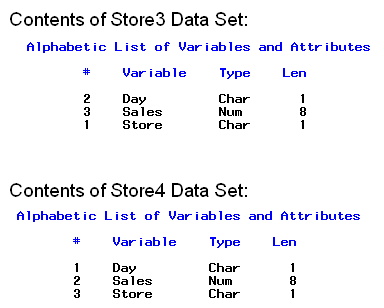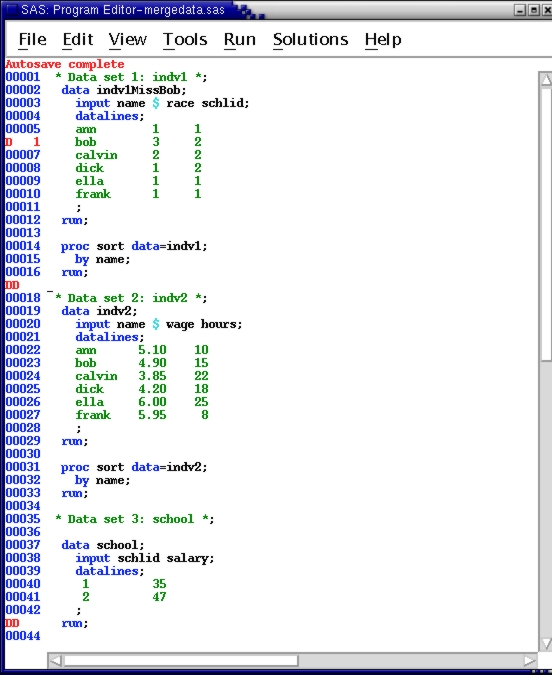

The variable list in the new data set will be a union of the two data sets. Using the multiple SET statements in a data step is one of the simplest methods for appending two or more datasets. Run Method 5: Using the multiple SET statements in the Data step In contrast, the default libref for the APPEND statement is the libref of the procedure input library specified in the libname= option of PROC DATASETS. The difference between PROC APPEND and the APPEND statement in PROC DATASETS is that the default libref is either WORK or USER in the case of PROC APPEND. A New dataset is not created when using PROC APPEND instead, the datasets mentioned in the BASE= are appended with the data set mentioned in the DATA=. PROC APPEND places the observations from one data set to the end of another data set. The APPEND will fail if there are any inconsistencies in the variables.

The APPEND statement in PROC DATASETS is an efficient method for appending two data tables. Method 3: Using the DATASETS Procedure’s APPEND Statement When the value of “ eof” is 1, the DO loop stops looping, and control passes to the next statement following the DO loop.END= eof in the INFILE statement is set to 1 when the last record is read from the external file.The external file is opened when the second INFILE statement with the FILEVAR= option is executed. The FILEVAR= option uses readcsv variable, which contains the name of the external file. In the second infile statement, the options are given concerning the contents of both files.As the data step iterates, a new value of “ readcsv” is read from the DATALINES.In the above example, the first infile statement reads the names of files from datalines and stores on readcsv variable.Infile subject dsd dlm="," LRECL=32760 filevar=readcsv end=eof

The FILEVAR= option of the INFILE statement can be used for reading multiple files and combining them into a single SAS dataset. Run Method 2: Using the FILEVAR option in INFILE You can select the Datastore URI to copy into your notebook/script. Find the file/folder you want to read into pandas, select the elipsis (. Select your datastore name and then Browse. filename subject ('/folders/myfolders/Data/september.csv''/folders/myfolders/Data/october.csv') Select Data from the left-hand menu followed by the Datastores tab. When the fileref is specified in an INFILE statement, each raw data file referenced can be sequentially read into a data set using an INPUT statement. You can use a FILENAME statement to concatenate raw data files by assigning a single fileref to the raw data files you want to combine. Using a FILENAME StatementįILENAME statement can be used for interleaving. Using multiple SET statements in the Data step.Using the DATASETS Procedure’s APPEND Statement.Several approaches can be taken when combining data sets vertically. The order of the data is based on the common variables specified.

I'm sure this is possible, just can't find the right type of code.The number of observations in the new data set is the sum of the number of observations of the input datasets. So all observations that do not match BOTH the date and ticker have to be dropped. Then after merge I would like to have something like this: What I want to do then is to merge these 2 databases based on the ticker and the month. and a second database which has an extra variable (let's say market capitalisation). So imagine I have 2 databases, one of which is the base database with variables such as Tickers, months, betas of a company (risk measure) etc. Y(jt) = c + X(jt) +X1(jt) etc with j = company (ticker) and t = time (month). The final purpose is to have a regression in the kind of I used month as a count variable throughout my time series.
#DATA MERGE IN SAS CODE#
Ford as F) usually seen on stock quotation boards).Īside from the ticker code to merge on I also have to merge on the time. A company is defined by its ticker code (the short version of the name (i.e. All of them contain information about 1000+ companies.


 0 kommentar(er)
0 kommentar(er)
